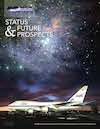The SOFIA flying observatory is a joint U.S.-German project (NASA & DLR). Although the nominal German project share is "only" 20%, the German side provides almost 50% of the instruments currently in operation with GREAT (German REceiver for Astronomy at Terahertz Frequencies, jointly operated by MPIfR and I. Phys. Inst. of Cologne Univ.), FIFI-LS (Field-Imaging Far-Infrared Line-Spectrometer) and FPI+ (Focal Plane Imager Plus). This is reflected by the fact that between 2009 and 2019, 45% of the peer-reviewed SOFIA publications are based on observations with these instruments. These include publications in the renowned science journal "Nature" such as the first detection of helium hydride (HeH+) - the first type of molecule in the universe - with the German GREAT instrument. With the same instrument, in addition to observations of astronomical objects, researchers can in parallel determine the concentration of atomic oxygen in the Earth's mesosphere and lower thermosphere, which is important in these layers for atmospheric models and climate change predictions (SOFIA/USRA Status Report report "Future & Prospects", 52 pages, 34 MB pdf file, April 13, 2022).
>> more
